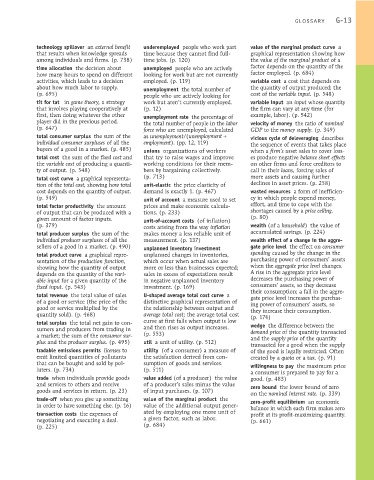Page 909 - Krugmans Economics for AP Text Book_Neat
P. 909
GLOSSARY G-13
technology spillover an external benefit underemployed people who work part value of the marginal product curve a
that results when knowledge spreads time because they cannot find full- graphical representation showing how
among individuals and firms. (p. 738) time jobs. (p. 120) the value of the marginal product of a
time allocation the decision about unemployed people who are actively factor depends on the quantity of the
how many hours to spend on different looking for work but are not currently factor employed. (p. 684)
activities, which leads to a decision employed. (p. 119) variable cost a cost that depends on
about how much labor to supply. unemployment the total number of the quantity of output produced; the
(p. 695) people who are actively looking for cost of the variable input. (p. 548)
tit for tat in game theory, a strategy work but aren’t currently employed. variable input an input whose quantity
that involves playing cooperatively at (p. 12) the firm can vary at any time (for
first, then doing whatever the other unemployment rate the percentage of example, labor). (p. 542)
player did in the previous period. the total number of people in the labor velocity of money the ratio of nominal
(p. 647) force who are unemployed, calculated GDP to the money supply. (p. 349)
total consumer surplus the sum of the as unemployment/(unemployment + vicious cycle of deleveraging describes
individual consumer surpluses of all the employment). (pp. 12, 119) the sequence of events that takes place
buyers of a good in a market. (p. 485) unions organizations of workers when a firm’s asset sales to cover loss-
total cost the sum of the fixed cost and that try to raise wages and improve es produce negative balance sheet effects
the variable cost of producing a quanti- working conditions for their mem- on other firms and force creditors to
ty of output. (p. 548) bers by bargaining collectively. call in their loans, forcing sales of
total cost curve a graphical representa- (p. 713) more assets and causing further
tion of the total cost, showing how total unit-elastic the price elasticity of declines in asset prices. (p. 258)
cost depends on the quantity of output. demand is exactly 1. (p. 467) wasted resources a form of inefficien-
(p. 549) unit of account a measure used to set cy in which people expend money,
total factor productivity the amount prices and make economic calcula- effort, and time to cope with the
of output that can be produced with a tions. (p. 233) shortages caused by a price ceiling.
given amount of factor inputs. unit-of-account costs (of inflation) (p. 80)
(p. 379) costs arising from the way inflation wealth (of a household) the value of
total producer surplus the sum of the makes money a less reliable unit of accumulated savings. (p. 224)
individual producer surpluses of all the measurement. (p. 137) wealth effect of a change in the aggre-
sellers of a good in a market. (p. 490) unplanned inventory investment gate price level the effect on consumer
total product curve a graphical repre- unplanned changes in inventories, spending caused by the change in the
sentation of the production function, which occur when actual sales are purchasing power of consumers’ assets
showing how the quantity of output more or less than businesses expected; when the aggregate price level changes.
depends on the quantity of the vari- sales in excess of expectations result A rise in the aggregate price level
able input for a given quantity of the in negative unplanned inventory decreases the purchasing power of
fixed input. (p. 543) investment. (p. 169) consumers’ assets, so they decrease
their consumption; a fall in the aggre-
total revenue the total value of sales U-shaped average total cost curve a gate price level increases the purchas-
of a good or service (the price of the distinctive graphical representation of ing power of consumers’ assets, so
good or service multiplied by the the relationship between output and they increase their consumption.
quantity sold). (p. 468) average total cost; the average total cost (p. 174)
total surplus the total net gain to con- curve at first falls when output is low wedge the difference between the
sumers and producers from trading in and then rises as output increases. demand price of the quantity transacted
a market; the sum of the consumer sur- (p. 553) and the supply price of the quantity
plus and the producer surplus. (p. 495) util a unit of utility. (p. 512)
transacted for a good when the supply
tradable emissions permits licenses to utility (of a consumer) a measure of of the good is legally restricted. Often
emit limited quantities of pollutants the satisfaction derived from con- created by a quota or a tax. (p. 91)
that can be bought and sold by pol- sumption of goods and services. willingness to pay the maximum price
luters. (p. 734) (p. 511)
a consumer is prepared to pay for a
trade when individuals provide goods value added (of a producer) the value good. (p. 483)
and services to others and receive of a producer’s sales minus the value zero bound the lower bound of zero
goods and services in return. (p. 23) of input purchases. (p. 107)
on the nominal interest rate. (p. 339)
trade-off when you give up something value of the marginal product the zero-profit equilibrium an economic
in order to have something else. (p. 16) value of the additional output gener- balance in which each firm makes zero
transaction costs the expenses of ated by employing one more unit of profit at its profit-maximizing quantity.
negotiating and executing a deal. a given factor, such as labor. (p. 661)
(p. 225) (p. 684)

